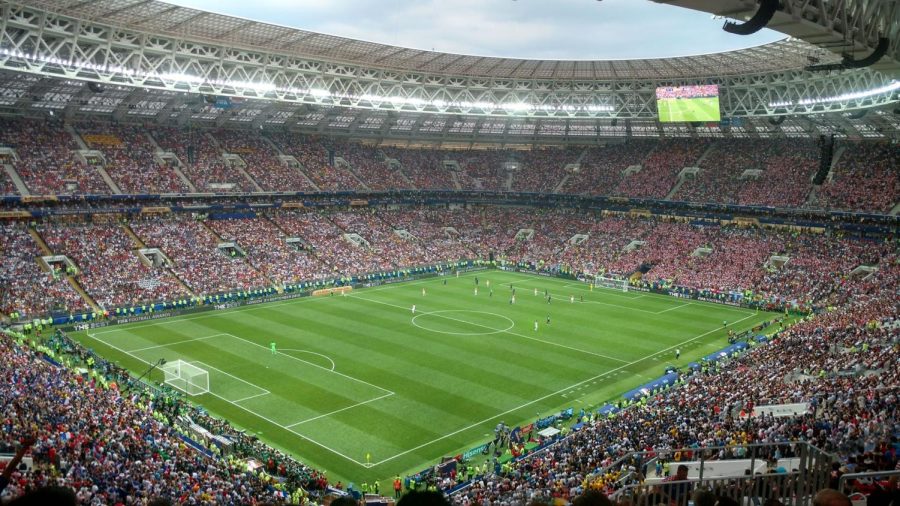FIFA and Qatar Face Backlash for 2022 World Cup
The 2018 FIFA World Cup Final, France vs. Croatia. (Photo by MX, CC BY-SA 4.0, via Wikimedia Commons)
February 10, 2023
In November, the FIFA 2022 World Cup kicked off in Qatar, reigniting the passion shared by soccer fans all over the world for one of the biggest sporting spectacles in history. The tournament, which was viewed by nearly half of the world’s population the last time it was held in 2018, according to FIFA, sees fans engage from every corner of the earth, donning their team’s colors and cheering on their favorite players. University of Utah students gathered in the A. Ray Olpin Student Union to watch alongside the rest of the world. But this time around, the world realized this year’s showcase came with very different connotations — ones that cannot be ignored, even in the spotlight of a global event.
When Qatar was awarded the rights to host the highly sought-after soccer tournament in 2010, the news was met with instant criticism. Not only was it expected that the United States would be favored for the decision, but Qatar was not suited to host such an extravagant ordeal due to a number of factors.
First, Qatar’s desert climate is far too hot, reaching well above 100 degrees Fahrenheit in the summer, when the World Cup is typically due to kick off. Such an environment is dangerous for players to be active in for extended periods of time, and could easily lead to health problems such as heat stroke and dehydration. This reason alone was enough for FIFA officials to alter the timeline of the Cup, postponing it to November of the same year in hopes of cooler and safer temperatures.
In addition, Qatar did not have the infrastructure needed to handle an event at the scale of a World Cup. With a total land size smaller than the state of Connecticut, Qatar was required to build several stadiums — that could hold tens of thousands of cheering fans — on top of any additional hotels or roads that were deemed necessary to fit the millions of supporters that would be visiting for the games. And in a country of less than three million residents, such an effort was not an easy feat to accomplish in the decade allotted to them.
Twelve years may seem like plenty of time for a host country to prepare its grounds and construct the necessary buildings to accommodate such a spectacle — really, that’s why FIFA announces the winning bids so far in advance — but Qatar was set at a slight disadvantage. Many recent host countries were already prominent in the sport, and had stadiums and other resources of the like ready to go. Qatar was essentially starting from scratch, and already had a strict deadline to plan, budget and execute their game plan. In the end, the country was successful, but not before certain claims came to light as to how they made it happen.
At the start of construction in Doha for the first of the renovations, the country saw a large influx of migrant workers coming from various regions in Asia and parts of Africa. Thirty thousand workers were contracted for crafting the stadiums alone, according to the government of Qatar. Many of these workers came because they were promised a salary that was higher than what could be obtained in their respective home countries. However, their new employment in Qatar seemingly did not live up to expectations — workers reported poor living conditions, and claimed that little water was provided while on the job in the excruciating heat, according to a report by PBS. These circumstances allowed health issues to run rampant.
Anish Adhikari, a migrant worker from Nepal, told PBS that often they were given rotten food, “the fish would smell disgusting. It used to give us diarrhea.”
Following these claims, Qatar reported that between 2014-20, there were 37 non-work related migrant worker deaths and three work-related deaths. Higher numbers were later reported, but rescinded.
However, an analysis by the Guardian supported by the Human Rights Watch showed that the embassies of South Asian countries that sent laborers reported just shy of 7,000 deaths. While these deaths were not categorized by occupation, many migrant workers in Qatar came to the country because of the World Cup. These numbers do not include data from countries such as the Philippines and Kenya, which also sent migrant workers for World Cup construction.
According to the Guardian, “The Qatar government says that the number of deaths – which it does not dispute – is proportionate to the size of the migrant workforce and that the figures include white-collar workers who have died naturally after living in Qatar for many years.”
The Human Rights Watch said with deaths remaining uninvestigated many families are left without answers or compensation.
FIFA President Gianni Infantino spoke about the deaths in a press conference during the World Cup.
“I think that every person dying is one person too many. It’s a tragedy. It’s a tragedy for the family, it’s a tragedy for everyone involved,” Infantino said.
During the World Cup, Qatar’s stance on LGBTQ+ rights also was called into question. Inside the country, homosexuality is illegal. Seven European countries were set to protest the anti-LGBTQ+ laws with the ‘One Love’ armband, but were threatened by FIFA that doing so would result in a yellow card.
Additionally, fans report they were kept out of matches for wearing rainbow paraphernalia to games, according to VOX.
With the crowning of Argentina as the new world champion team, FIFA looks to transition to the 2026 World Cup, set to be here in North America.













Russel Couch • Feb 10, 2023 at 8:09 am
Sensational headline setting up a lazy, gratuitous report. Nothing new, repeating tired, second hand ‘journalism’.